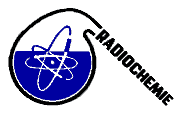Speaker
Dr
Peter Steier
(VERA Laboratory, Faculty of Physics – Isotope Research, University of Vienna, Währingerstr. 17, A-1090 Vienna, Austria)
Description
236U (half-life 23∙Myr) is produced in uranium ore via thermal neutron capture on 235U. The neutrons originate mainly from (α,n) reactions caused by α-particles from the uranium decay series. The equilibrium ratio of 236U/U in natural ore is proportional to the thermal neutron flux, which is expected to be proportional to the uranium concentration in first approximation. Since this fingerprint of high grade ore should stay unaltered in withering and dissolution, it should still be detectable in well water which was in subsurface contact with the ore; thus, such wells should be useful as natural probes for uranium prospection. We expect this signature to be more unambiguous than the uranium concentration in water, recently investigated e.g. in 1. However, measurement capabilities for 236U were developed recently only at very few AMS (Accelerator Mass Spectrometry) facilities, among these at VERA (Vienna Environmental Research Accelerator).
We will discuss the feasibility of uranium prospection by using natural 236U in well water, and summarize existing measurements. Uranium ores show up to 236U/U=10-10, but measurements of uranium from low-concentration rocks or deep well water are sparse or unavailable 2. The connection between uranium concentration and the 236U/U ratio will be discussed, since trace isotopes (serving as (α,n) targets and "neutron poisons") and water content of the rock can alter the 236U production significantly.
A known highest grade ore deposit was located in Jáchymov, Czech Republic. It is mainly depleted now, but is a perfect test case to investigate whether high grade ore is indicated by high 236U/U concentration in well water in the vicinity. Thus, the Jáchymov region could be a perfect test case to study 236U in well water as a tool for uranium prospection.
References:
1. Mehra P., Singh S., Singh K.: Radiation Measurements 42, 441 (2007).
2. Steier P., Bichler M., Fifield L. K., Golser R., Kutschera W., Priller A., Quinto F., Richter S., Srncik M., Terrasi P., Wacker L., Wallner A., Wallner G., Wilcken K. M., Wild E. M.: Nucl. Instr. and Meth. B 266, 2246 (2008).
Primary author
Dr
Peter Steier
(VERA Laboratory, Faculty of Physics – Isotope Research, University of Vienna, Währingerstr. 17, A-1090 Vienna, Austria)
Co-authors
Prof.
Gabriele Wallner
(Department of Inorganic Chemistry, University of Vienna, Währingerstr. 42, A-1090 Vienna, Austria)
Prof.
Jan John
(Centre for Radiochemistry and Radiation Chemistry/ Dept. Of Nuclear Chemistry, Faculty of Nuclear Sciences and Physical Engineering, Czech Technical University in Prague, Břehová 7, 11519 Prague, Czech Republic)
Ms
Michaela Srncik
(Department of Inorganic Chemistry, University of Vienna, Währingerstr. 42, A-1090 Vienna, Austria)
Dr
Mojmír Němec
(Centre for Radiochemistry and Radiation Chemistry/ Dept. Of Nuclear Chemistry, Faculty of Nuclear Sciences and Physical Engineering, Czech Technical University in Prague, Břehová 7, 11519 Prague, Czech Republic)

